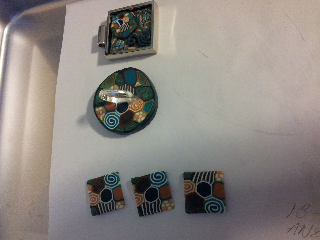In my day job, I'm a scientist and the scientific world around me always seems to skulk its way into my bank of inspiration!! Believe it or not there are many dazzling phenomena in the mundane daily lab life to inspire beautiful polymer clay pieces. The first piece I attempted was a variation on a protein crystal structure. Incorporating extruded brightly coloured clay to represent the common alpha helix and beta sheet forms.
Then I found my flower petal canes turning into E.coli with stripey flagella on this pendant!
My backdrop for this pendant looked so much like a fingerprint after I textured it that I went with a forensic science theme, with a trail of blood for the forensic scientists to follow and blood drops to be analysed.
Inishkea - explorations in polymer clay
Sunday 27 October 2013
Sunday 7 July 2013
New Facebook Page
I've just launched my new facebook page:
Inishkea Facebook Page
Make sure you pop by and like my page to get all the updates on new blogs, new pieces and news on markets and stockists.
I also created some funky posters to display on my market stall to showcase Inishkea.
Wednesday 3 July 2013
Shifty polymer - playing with Mica Shift effects
Mica shift is a technique used in polymer clay work requiring metallic or pearl clay. These clays contain mica particles, which can be aligned by passing your clay through your pasta machine repeatedly in the same direction. An impression can then be left in the clay with a rubber stamp or the like. Using a fine, flat tissue blade to remove the uppermost layer of clay miraculously leaves you with a smooth flat piece of clay with a seemingly 3-dimensional pattern in it.
I recently discovered the fantastic tutorials over at CraftArtEdu. And after watching Carol Blackburn's mica clay tutorial (http://craftartedu.com/polymer-clay/carol-blackburn-free-basic-introduction-to-mica-clay), I played around with her idea to try two very different coloured mica clays with the mica shift technique. I used my bronze and pearl (with a bit of white mixed through it) Kato clays and a couple of different texture sheets and rubber stamps. The bangle below was made by alternating panels from different mica shift sheets on a base of marbled clay.
Thursday 27 June 2013
Hanging aROUND! Making a round pendant...
Here is my photo diary of how I made a round pendant.
 |
| I formed some scrap clay into the rough round shape I wanted the pendant to be by warming it and pressing against my tile work surface. |
 |
| The other sheet of purple clay was used to cover both top and bottom of my rounded scrap clay. |
 |
| I used circular cutters to cut out a piece of the smoothed cane veneer sheet and also another smaller piece of the plain purple sheet. I laid these on top of the pendant, off-centre. |
 |
| Round pendant ready to bake. |
 |
| I completed the pendant by wet sanding with 3 different grits of sandpaper then buffing to a shine. I attached a silver bail to the back for hanging from a chain. |
Tuesday 25 June 2013
Poly Pipe Cane Tutorial
I saw a truck, the other day, carrying a massive load of poly pipe all stacked up on the back. It inspired me to get creative with my extruder. Here's a tutorial for my new Poly Pipe cane, instructions are in the captions! I've tried this with a few colour combos (as shown in the pictures at the end) and it's really effective.
 |
| Condition your clay and then roll it out on a medium setting on your pasta machine. Lay the clay flat on your work surface. |
 |
| Cut out circles of clay using the extruder barrel. |
 |
| Neaten stacks and reduce slightly to ensure they can fir inside the extruder barrel. |
 |
| Extrude your clay stacks into snakes using 4 different sized extruder discs. Make 2 snakes at the 3 larger sizes and 1 snake at the smallest size. |
 |
| Cut all snakes into 8cm segments. |
 |
| Stack the clay segments randomly, forming a cane. Fill gaps with the smaller diameter segments. |
 |
| Voila! Your Poly Pipe cane :) |
 |
| Poly Pipe cane pendant |
 |
| A different version of the Poly Pipe cane |
 |
| Poly Pipe cane used for flower petals |
| Poly Pipe cane pendant |
Tuesday 18 June 2013
Burning up
Thursday 13 June 2013
Bettina Welker's Pixelated Retro Blend Cane
I saw the fabulous Pixelated Retro Blend Cane on polymer clay daily a couple of weeks ago and just HAD to give this a try! Lucky for me Bettina Welker has very generously published a tutorial on her website...yay!
I just love the effects you can achieve with an extruder and this cane really shows off some of that potential. My first play was following Bettina's tutorial as closely as possible. I didn't end up making a very large cane so only made two pieces from it and a few beads.
I varied the technique slightly by using a square extruder disc and I loved the effect, the cane is lovely. Thanks Bettina!!
Subscribe to:
Posts (Atom)















